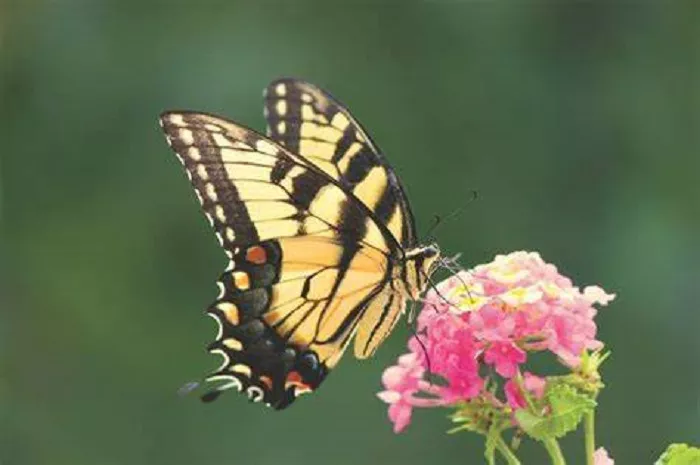In the enchanting world of gardens, few sights are as captivating as the graceful dance of swallowtail butterflies. These delicate creatures, with their vibrant wings and elegant movements, add a touch of magic to any garden. But what draws them in? The answer lies in the flowers they love. Understanding which flowers attract swallowtail butterflies can transform your garden into a haven for these beautiful insects. Let’s delve into the fascinating relationship between swallowtails and the blooms they cherish.
The Allure of Nectar-Rich Flowers
Swallowtail butterflies are drawn to flowers that offer an abundant supply of nectar. These butterflies have a long proboscis, a straw-like tongue, which they use to sip nectar from flowers. Nectar is their primary food source, providing the energy they need to fly and reproduce. Flowers with tubular shapes are particularly appealing, as they allow the butterflies to easily access the nectar. Some of the best nectar-rich flowers for swallowtails include butterfly bush (Buddleia), lantana, and verbena. These plants produce clusters of small flowers, each filled with sweet nectar, making them irresistible to swallowtails.
Color Preferences of Swallowtail Butterflies
When it comes to color, swallowtail butterflies have distinct preferences. They are particularly attracted to bright and bold colors such as yellow, orange, red, and purple. These vibrant hues stand out in the garden and signal the presence of nectar-rich flowers. For example, black-eyed Susans (Rudbeckia) with their cheerful yellow petals and dark centers are a favorite. Similarly, coneflowers (Echinacea) in shades of pink and purple provide both visual appeal and a valuable nectar source. Incorporating a variety of these colorful flowers into your garden will create a visually stunning display that also attracts swallowtails.
The Role of Native Plants
Native plants play a crucial role in attracting swallowtail butterflies. These plants have evolved alongside the local wildlife and provide the best possible habitat and food sources. Native flowers are often more resilient and require less maintenance, making them an ideal choice for gardeners. For instance, milkweed (Asclepias) is not only a host plant for monarch butterflies but also a nectar source for swallowtails. Other native plants like goldenrod (Solidago) and asters (Symphyotrichum) bloom in late summer and fall, providing a continuous supply of nectar for swallowtails as they prepare for migration or overwintering.
Host Plants for Swallowtail Caterpillars
To truly support swallowtail butterflies, it’s essential to provide not only nectar sources but also host plants for their caterpillars. Swallowtail caterpillars are picky eaters and rely on specific plants to survive. For example, the black swallowtail prefers plants in the carrot family, such as parsley, dill, and fennel. These plants are easy to grow and can be incorporated into both vegetable and flower gardens. The tiger swallowtail often uses cherry and willow trees as host plants, while the spicebush swallowtail relies on spicebush (Lindera benzoin) and sassafras (Sassafras albidum). By including these host plants in your garden, you can support the entire life cycle of swallowtail butterflies, from egg to adult.
Creating a Butterfly-Friendly Garden
Designing a garden that attracts swallowtail butterflies involves more than just planting the right flowers. It’s about creating a holistic environment that meets their needs. Start by choosing a sunny location, as most nectar-rich flowers thrive in full sun. Plant flowers in clusters rather than singly, as this makes it easier for butterflies to move from one flower to another. Include a variety of flowers that bloom at different times of the year to provide a continuous supply of nectar. Adding a shallow water source, such as a birdbath with pebbles, can also provide a place for butterflies to drink and rest.
The Importance of Pesticide-Free Gardening
Pesticides can be harmful to butterflies and other beneficial insects. To create a safe haven for swallowtail butterflies, it’s important to avoid the use of chemical pesticides in your garden. Instead, opt for natural pest control methods such as introducing beneficial insects like ladybugs and lacewings, which prey on common garden pests. Using organic gardening practices not only protects butterflies but also promotes a healthier ecosystem overall. A garden free from harmful chemicals will attract a diverse range of wildlife, enhancing its beauty and ecological value.
Seasonal Blooms for Continuous Attraction
To keep swallowtail butterflies visiting your garden throughout the season, it’s essential to have a variety of flowers that bloom at different times. In spring, violets (Viola) and phlox (Phlox) provide early nectar sources. As summer arrives, bee balm (Monarda) and coreopsis (Coreopsis) take center stage with their bright and fragrant blooms. In late summer and fall, asters and goldenrod continue to attract swallowtails with their abundant nectar. By carefully selecting flowers that bloom sequentially, you can ensure that your garden remains a welcoming place for these beautiful insects all season long.
The Magic of Butterfly Gardens
Creating a butterfly garden is more than just a hobby; it’s a way to connect with nature and contribute to the conservation of these incredible creatures. Watching swallowtail butterflies flit from flower to flower is a magical experience that brings joy and a sense of wonder. A well-designed butterfly garden not only attracts swallowtails but also supports a diverse range of pollinators, including bees, hummingbirds, and other butterflies. It becomes a living ecosystem, teeming with life and activity.
Conclusion
Swallowtail butterflies are a beautiful addition to any garden, and by understanding their preferences, you can create a space that they will love. From nectar-rich flowers to vibrant colors and native plants, there are many ways to attract these delicate creatures. By providing host plants for their caterpillars and maintaining a pesticide-free environment, you can support their entire life cycle. A butterfly-friendly garden is a haven for wildlife and a source of endless fascination for gardeners. So, plant those flowers, sit back, and enjoy the enchanting dance of swallowtail butterflies in your garden.


